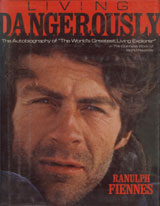
Exciting tales boringly told
|
This review first appeared in the San Diego Evening Tribune in 1988.
Ranulph Fiennes' life story rambles from a childhood in South Africa to a trans-polar circumnavigation of the globe, over the deserts of Oman and through the wildest rapids of British Columbia. "The Guinness Book of World Records" described the former British SAS officer as "The world's greatest living explorer."
Given the above, one would expect Fiennes' autobiography, "Living Dangerously," to read like a real-life Ian Fleming novel. But while the events of Fiennes' life story are fascinating, the telling of them is stiflingly boring. It may be Fiennes' military background as an officer in the Royal Scots Greys and the SAS, but whatever the reason, "Living Dangerously" reads like one of those stuffy military histories the British are so famous for turning out.
The events of Fiennes' life are described in minute detail, but the emotions he felt at the time are described in cold, aloof terms that tell us little of what these experiences were truly like. A prime example of this aloofness comes from an incident in which Fiennes nearly drowned. While training north of Greenland for the trans-polar exploration, Fiennes fell through a hole in the ice:
"Suddenly the surface began to move beneath my boots, a crack opened up and black water gushed rapidly over the floe, rushing over my boots and weighing down on the fragile new ice. As the water rose to my knees, the crust under my feet cracked apart. I sank quickly but my head could not have been submerged more than second, as the air trapped under my wolfskin acted as a life-jacket. The nearest solid floe was thirty yards away. I shouted for the others, but of course there was no-one about. Each time I tried to heave myself up onto a section of the submerged crust, I broke it again. I crawled and clawed and shouted ... I began to tire. My toes felt numb and there was no sensation inside my mitts. My chin, inside the parka, sank lower as my clothes became heavier. I began to panic. After four, perhaps five minutes, my escape efforts had weakened to a feeble pawing movement when, ecstatic moment, one arm slapped down on to a solid ice chunk and I levered my chest on to a skein of old ice.
The highest value of a book such as "Living Dangerously" is its ability to share with others extraordinary experiences that push men to their very limits. But Fiennes seems content to offer us a nutrition-poor diet: lots of starch in adventure, but little of the emotional impact necessary to feed the reader's imagination.
The most revealing passage is early in the book, when Fiennes tells of his days at Eton. His matter-of-fact descriptions of underground homosexual behavior and the intimidation of younger boys into sexual relationships captures the confused, helpless feelings of adolescence. However, after this chapter concludes, so does Fiennes' delving into anything other than superficial descriptions of emotional issues.
If one reluctantly accepts the fact that Fiennes' writing will not shed much light on what drives a man to deeds such as parachuting onto a dangerous glacier in Norway or following the Nile to its head on hydrocraft, "Living Dangerously" serves as a very thorough historical text of these explorations.
The narrative of each trip is extensively backed up with maps, charts and photographs that outline and illustrate the sheer danger and utter beauty of some of the most inaccessible locations on the planet. And like those hated but admired British military histories, Fiennes retains his objectivity even when discussing his own shortcomings.
The disappointment in "Living Dangerously stems from the unfulfilled realization of what the book might have been. Peter Boardman's "The Shining Mountain," for instance, bared the emotional impact of extreme mountaineering on the climber. Certainly Fiennes' experiences have been no less moving, and his failure to convey that leaves a hole in his book.
